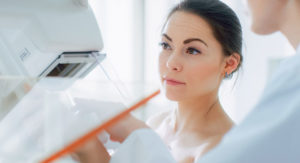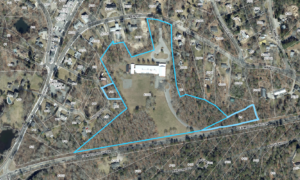 HYANNIS – Less than eight years ago, 3D mammography (tomosynthesis) received FDA approval for breast cancer screening. As with all new technologies, scientific understanding of the technology continues to grow as clinicians’ and researchers’ experience with it matures.
HYANNIS – Less than eight years ago, 3D mammography (tomosynthesis) received FDA approval for breast cancer screening. As with all new technologies, scientific understanding of the technology continues to grow as clinicians’ and researchers’ experience with it matures.
Lara Bryan-Rest, MD, a radiologist with Cape Cod Healthcare’s Seifer Women’s Health and Imaging Center at Falmouth Hospital, explained what the latest studies say and what’s in store for screening mammography.
Traditional 2D mammography provides two X-rays of each breast, from top to bottom and angled side-to-side. But 3D mammography, or ‘tomosynthesis,’ uses low-dose X-ray to image each breast from different angles, capturing many pictures of thin layers of tissue. These are then reconstructed so the radiologist can scroll through the layers of tissue in the breast.
Radiologists view the images to differentiate between healthy tissue and any abnormalities. The results are then reported to both the patient and the patient’s referring doctor. Any woman who needs additional evaluation is contacted by a breast care navigator.
Since 1990, breast cancer mortality rates have fallen between 1.8 percent and 3.4 percent per year, a decrease that is attributed to increased mammography screening and advanced treatment, according to a report in the February 2019 issue of Cancer, a publication of the American Cancer Society.
What to Expect With 3D
When a woman in the U.S. has a 3D mammogram, there is always an accompanying 2D mammogram, because of current FDA requirements, Dr. Bryan-Rest said.
“The FDA has not approved the use of 3D mammography, alone,” she said. “The 2D breast image is essential because it gives radiologists an overview of the breasts. We want to see symmetry between the breasts and be able to compare previous studies to find any subtle changes over time. It is harder to do that with a stack of 3D images.”
You don’t move from one machine to another to have a 2D and then a 3D mammogram.
“Women notice only a minimal change from having just a 2D mammogram because each picture takes slightly longer to get all the data needed,” Dr. Bryan-Rest said.
Each breast is compressed between two plates to get the clearest image of breast tissue, she explained. A screening mammogram of both breasts is just four pictures, two of each breast. A 3D picture is taken, there is a small pause, and a 2D picture is taken. All on the same machine.
“The machines we use at Cape Cod Healthcare have one of the shortest exposure times for the tomosynthesis, which is great. That’s a shorter time to have to hold your breath. And all the pictures we need are acquired right in that single breath hold for each image,” she said.
While the American College of Radiology estimates that only about 30 percent of mammography units in U.S. Hospitals and imaging facilities have 3D capabilities, Cape Cod Healthcare offers 3D mammography at three locations:
Cuda Women’s Health Center at the Wilkens Outpatient Medical Complex, Hyannis
Seifer Women’s Health and Imaging Center at Falmouth Hospital
Fontaine Outpatient Center in Harwich
New Studies Confirm Benefits
After screening 15,000 women over five years, a major clinical study released in Lancet Oncology said 3D mammography detects 34 percent more breast cancers as compared to traditional 2D mammography—with a majority of the detected tumors proving to be invasive cancers.
Another study published in Radiology from the Radiological Society of North America found that a combination of digital (2D) mammography and tomosynthesis detects 90 percent more breast cancers than digital mammography alone.
These studies confirm what Cape Cod Healthcare radiologists see in their practices, said Dr. Bryan-Rest.
“The great benefit of tomosynthesis has been our improved ability to detect invasive cancers,” she said.
Unlike in situ (non-invasive) cancers, invasive cancers are more likely to spread to lymph nodes and other parts of the body, so we want to find more of the invasive cancers, she said.
One thing the industry is studying is computer-generated synthetic 2D images created entirely from 3D data, said Dr. Bryan-Rest.
“Being able to use synthetic images derived from 3D data would eliminate the need for women to have both 2D and 3D mammograms, reducing radiation exposure and streamlining mammogram testing. That would be great, and I believe we’ll get there as a field, eventually,” she said.
Some vendors currently have the technology available. However, given the differences in appearance between standard and synthetic images, it will take time and experience before synthetic 2D images will be widely used.
A Risk of Over-Diagnosis?
One of the questions research studies consistently address is if new technology will lead to over-diagnosis. In other words, will doctors find more of the cancers that will never impact a person’s life, which could result in unnecessary intervention and give patients undo concern?
“My first answer to that is: we don’t yet know which cancers will spread or progress and become life-threatening,” said Dr. Bryan-Rest. “We know there is a wide range of biological activity in cancer, particularly non-invasive cancers, and that’s where we need more research. For now, I think it’s best to be able to give patients as much information as possible so they can make informed decisions.
“Secondly, one of the most positive outcomes of tomosynthesis is that we’re increasing the detection of invasive cancers and not in situ cancers. That’s good news. Early diagnosis is key to stopping cancer.”























